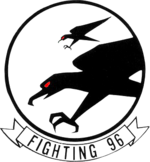|
VF-96
Fighter Squadron 96, or VF-96 Fighting Falcons was an aviation unit of the United States Navy in service from 1962 to 1975. When assigned to Carrier Air Wing Nine (CVW-9) their tailcode was NG, and their radio callsign was Showtime. Originally established as United States Naval Reserve squadron VF-791 Fighting Falcons on 20 July 1950 it was redesignated VF-142 after becoming a regular squadron on 4 February 1953. It was re-designated VF-96 on 1 June 1962 and disestablished on 1 December 1975.[1] History    VF-791 was assigned to Carrier Air Group 101 (CVG-101) aboard USS Boxer for a deployment to the Western Pacific and Korea from 2 March to 24 October 1951. During this deployment VF-783 lost 4 F4U-4s.[2] VF-142 was assigned to Carrier Air Group 14 (CVG-14) aboard USS Randolph for a Mediterranean deployment from 3 February to 6 August 1954. VF-142 was assigned to CVG-14 aboard USS Ranger for a deployment to the Western Pacific from 3 January to 27 July 1959. VF-142 was assigned to CVG-14 aboard USS Oriskany for a deployment to the Western Pacific from 14 May to 15 December 1960. VF-142 was assigned to Carrier Air Group 11 (CVG-11) aboard USS Kitty Hawk for her voyage around South America from 11 August to 1 November 1961. VF-96 was assigned to Carrier Air Wing Nine aboard the aircraft carrier USS Ranger for a deployment to the Western Pacific from 9 November 1962 to 14 June 1963. VietnamVF-96 embarked aboard USS Ranger for a deployment to Vietnam from 5 August 1964 to 6 May 1965. On 9 April 1965 an F-4B #151425 from VF-96 crashed into the sea following an engine flameout on launch for a four-plane combat air patrol.[3] Later during the patrol an F-4B #151403 piloted by Lieutenant j.g. Terence M. Murphy and his RIO, Ensign Ronald Fegan, shot down a Chinese MiG-17 "Fresco" near Hainan, scoring the F-4 Phantom's first air-to-air victory. The Phantom was then shot down either by another MiG or, as enemy reports later indicated, an AIM-7 Sparrow from one of Murphy's and Fegan's wingmen.[4][5] Murphy and Fegan were listed as killed in action, body not recovered.[6][7] VF-96 embarked aboard the aircraft carrier USS Enterprise for a deployment to Vietnam from 26 October 1965 to 21 June 1966. On 12 February 1967, Lieutenant Commander Martin Sullivan and Lieutenant j.g. Paul Carlson flying F-4B #152219 crashed at sea during intercept training.[8][9] On 9 May 1968 USAF exchange pilot Captain John Heffernan and his RIO Lieutenant j.g. Frank Schumacher shot down a Vietnam People's Air Force (VPAF) MiG-21 with an AIM-7.[5]: 60–62  Six squadron F-4Js were destroyed and ten crewmen killed during the USS Enterprise fire on 14 January 1969. VF-96 embarked aboard USS America for a deployment to Vietnam from 10 April to 21 December 1970.  VF-96 embarked aboard USS Constellation for a deployment to Vietnam from 1 October 1971 to 1 July 1972. During this deployment, on 10 May, Lieutenant Duke Cunningham and Lieutenant j.g. William P. Driscoll of VF-96 scored their aerial victories becoming the only US Navy aces of the war. Three more VPAF MiG-17s were downed by two other VF-96 crews that same day, two by Lieutenant Michael J. Connelly and Lieutenant Thomas J. Blonski and one by Lieutenant Steven C. Shoemaker and Lieutenant j.g. Keith V. Crenshaw. VF-96 again embarked on Constellation for its final Vietnam cruise from 5 January to 11 October 1973. Between 21 June and 23 December 1974 the Fighting Falcons along with sister-squadron VF-92 made its last operational deployment with CVW-9, aboard Constellation, before being disestablished on 1 December 1975. Home port assignmentsAircraft assignmentNotable members
See also
References
External links |
||||||||||||||||||||||

